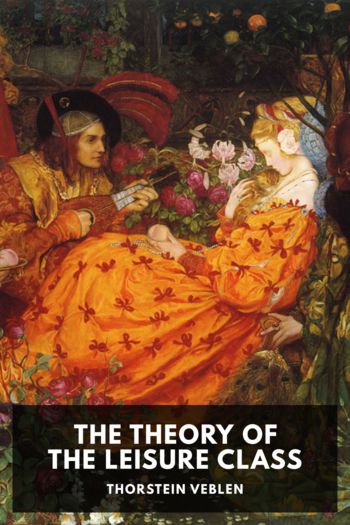The Theory of the Leisure Class - Thorstein Veblen (english books to improve english txt) 📗

- Author: Thorstein Veblen
Book online «The Theory of the Leisure Class - Thorstein Veblen (english books to improve english txt) 📗». Author Thorstein Veblen
The dog has advantages in the way of uselessness as well as in special gifts of temperament. He is often spoken of, in an eminent sense, as the friend of man, and his intelligence and fidelity are praised. The meaning of this is that the dog is man’s servant and that he has the gift of an unquestioning subservience and a slave’s quickness in guessing his master’s mood. Coupled with these traits, which fit him well for the relation of status—and which must for the present purpose be set down as serviceable traits—the dog has some characteristics which are of a more equivocal aesthetic value. He is the filthiest of the domestic animals in his person and the nastiest in his habits. For this he makes up is a servile, fawning attitude towards his master, and a readiness to inflict damage and discomfort on all else. The dog, then, commends himself to our favor by affording play to our propensity for mastery, and as he is also an item of expense, and commonly serves no industrial purpose, he holds a well-assured place in men’s regard as a thing of good repute. The dog is at the same time associated in our imagination with the chase—a meritorious employment and an expression of the honorable predatory impulse. Standing on this vantage ground, whatever beauty of form and motion and whatever commendable mental traits he may possess are conventionally acknowledged and magnified. And even those varieties of the dog which have been bred into grotesque deformity by the dog-fancier are in good faith accounted beautiful by many. These varieties of dogs—and the like is true of other fancy-bred animals—are rated and graded in aesthetic value somewhat in proportion to the degree of grotesqueness and instability of the particular fashion which the deformity takes in the given case. For the purpose in hand, this differential utility on the ground of grotesqueness and instability of structure is reducible to terms of a greater scarcity and consequent expense. The commercial value of canine monstrosities, such as the prevailing styles of pet dogs both for men’s and women’s use, rests on their high cost of production, and their value to their owners lies chiefly in their utility as items of conspicuous consumption. Indirectly, through reflection upon their honorific expensiveness, a social worth is imputed to them; and so, by an easy substitution of words and ideas, they come to be admired and reputed beautiful. Since any attention bestowed upon these animals is in no sense gainful or useful, it is also reputable; and since the habit of giving them attention is consequently not deprecated, it may grow into an habitual attachment of great tenacity and of a most benevolent character. So that in the affection bestowed on pet animals the canon of expensiveness is present more or less remotely as a norm which guides and shapes the sentiment and the selection of its object. The like is true, as will be noticed presently, with respect to affection for persons also; although the manner in which the norm acts in that case is somewhat different.
The case of the fast horse is much like that of the dog. He is on the whole expensive, or wasteful and useless—for the industrial purpose. What productive use he may possess, in the way of enhancing the well-being of the community or making the way of life easier for men, takes the form of exhibitions of force and facility of motion that gratify the popular aesthetic sense. This is of course a substantial serviceability. The horse is not endowed with the spiritual aptitude for servile dependence in the same measure as the dog; but he ministers effectually to his master’s impulse to convert the “animate” forces of the environment to his own use and discretion and so express his own dominating individuality through them. The fast horse is at least potentially a racehorse, of high or low degree; and it is as such that he is peculiarly serviceable to his owner. The utility of the fast horse lies largely in his efficiency as a means of emulation; it gratifies the owner’s sense of aggression and dominance to have his own horse outstrip his neighbor’s. This use being not lucrative, but on the whole pretty consistently wasteful, and quite conspicuously so, it is honorific, and therefore gives the fast horse a strong presumptive position of reputability. Beyond this, the racehorse proper has also a similarly nonindustrial but honorific use as a gambling instrument.
The fast horse, then, is aesthetically fortunate, in that the canon of pecuniary good repute legitimates a free appreciation of whatever beauty or serviceability he may possess. His pretensions have the countenance of the principle of conspicuous waste and the backing of the predatory aptitude for dominance and emulation. The horse is, moreover, a beautiful animal, although the racehorse is so in no peculiar degree to the uninstructed taste of those persons who belong neither in the class of racehorse fanciers nor in





Comments (0)